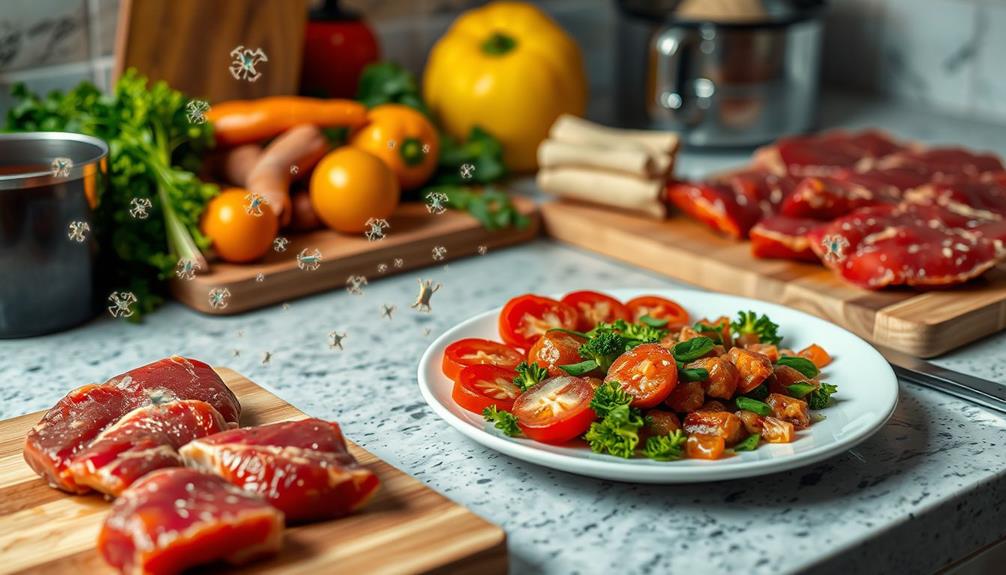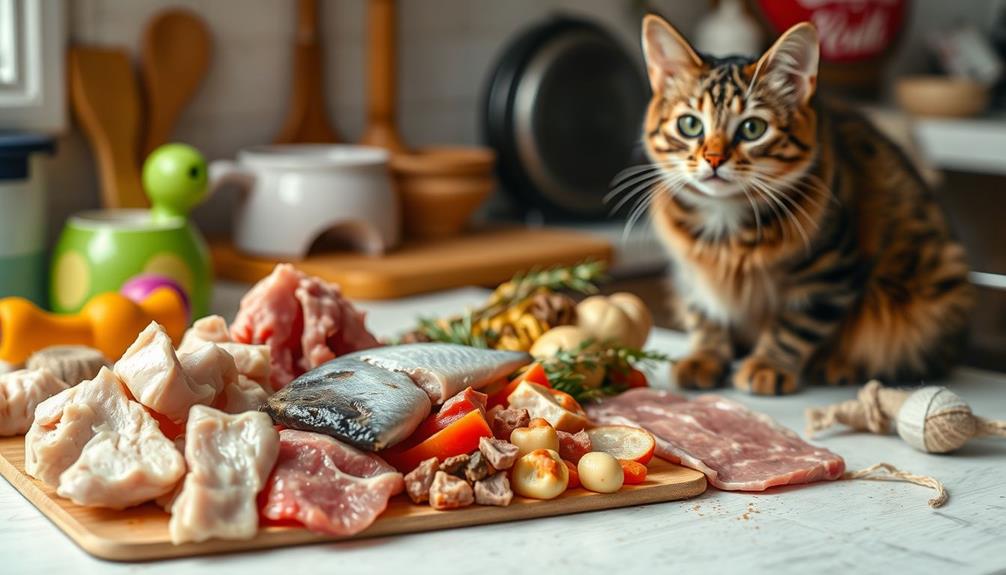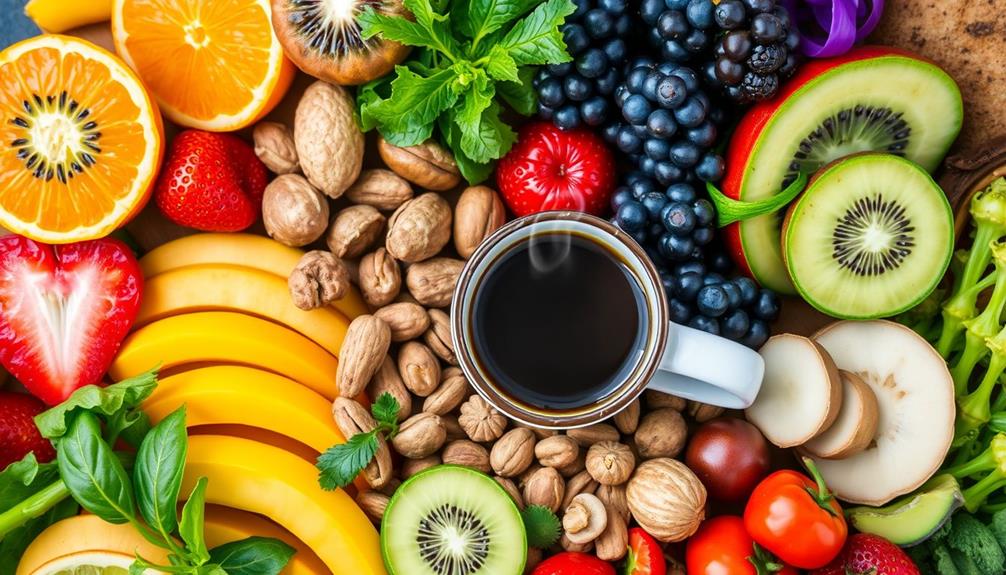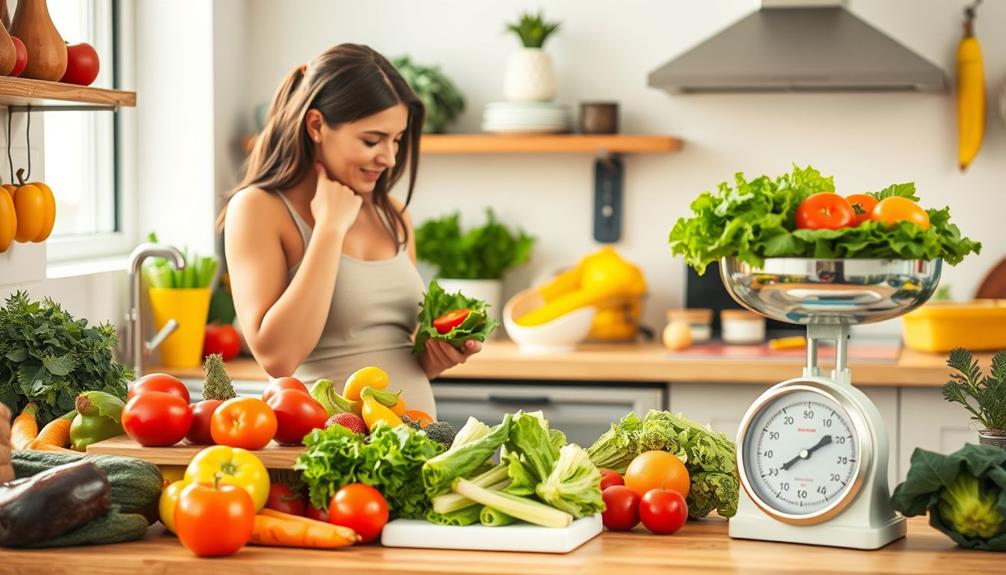Bacteria can spread from raw food to ready-to-eat food in just minutes if you don't follow proper food handling practices. If raw meats come into contact with surfaces, utensils, or even your hands, you risk cross-contamination. Under the right conditions, bacteria can double in numbers every 10 to 20 minutes, particularly in the danger zone between 40°F and 140°F. To prevent this spread, it's essential to wash your hands regularly and keep raw and ready-to-eat foods separate. Understanding these risks can help you guarantee food safety and avoid potential illness. There's much more to reflect on regarding safe food practices.
Key Takeaways
- Bacteria can transfer from raw food to ready-to-eat food in as little as minutes during improper handling or food preparation.
- Cross-contamination risks increase significantly when using the same surfaces or utensils for raw and ready-to-eat foods without cleaning.
- The microbial load on raw foods influences contamination speed; higher loads can lead to quicker bacterial spread.
- Salmonella, for example, can double in number every 20 minutes in the danger zone of 40°F to 140°F.
- Effective hygiene practices, such as handwashing and sanitizing, are crucial to prevent rapid bacterial transfer.
Understanding Bacterial Contamination
Bacterial contamination is a serious concern in the kitchen, especially when raw food comes into contact with ready-to-eat items. This cross-contamination primarily occurs during food handling and preparation, where harmful bacteria from raw meats can transfer to surfaces, utensils, or even your hands.
Understanding the importance of proper food safety practices is essential in preventing such incidents, as highlighted in cold medications overview. Once this happens, your ready-to-eat food is at risk.
The danger zone for bacterial growth lies between 40°F and 140°F (4°C and 60°C). In this range, bacteria can double in number in as little as 20 minutes, making time a key factor. If you leave foods in this danger zone for more than two hours, you should discard them to minimize the risk of contamination.
To combat bacterial contamination, it's important to practice proper food safety. Always wash your hands thoroughly after handling raw food, and sanitize surfaces immediately.
Types of Foodborne Illnesses
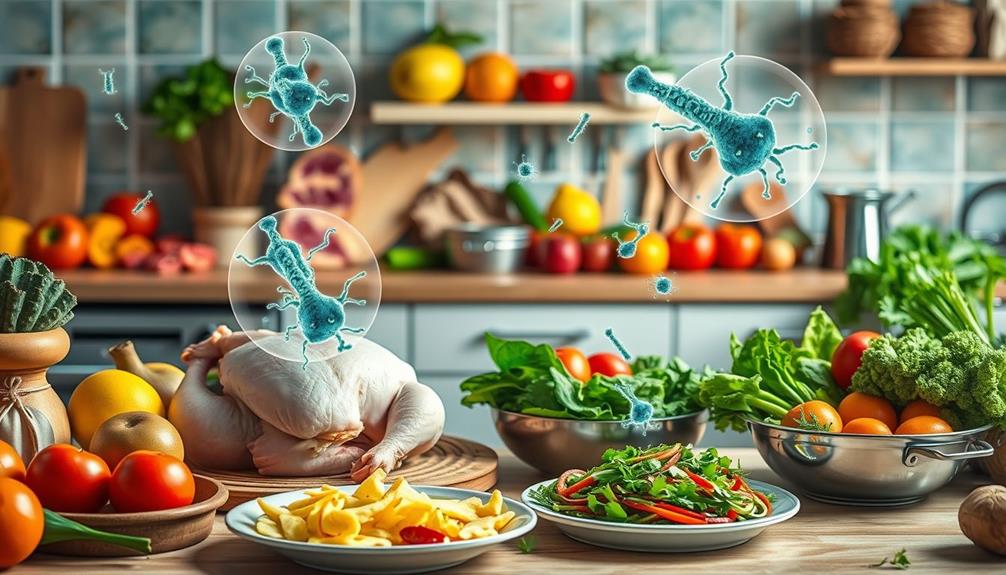
When it comes to foodborne illnesses, you need to understand the difference between food intoxication and food infection.
In food intoxication, toxins from bacteria cause illness, while food infection happens when you consume the bacteria themselves.
Individuals with certain mental health disorders, such as Borderline Personality Disorder (BPD), may experience heightened anxiety around food safety, which can exacerbate their symptoms.
Recognizing the symptoms and consequences of these illnesses is key to keeping yourself and others safe.
Food Intoxication Overview
Food intoxication is a serious concern in the culinary world, where harmful bacteria can turn a delicious meal into a health risk. This occurs when foodborne illness-causing bacteria, such as Staphylococcus aureus, Clostridium perfringens, and Bacillus cereus, produce toxins in improperly stored or handled foods.
High-quality content about food safety practices is vital for educating consumers on these risks. Symptoms can strike quickly, often within 1-6 hours after ingestion, leading to nausea, vomiting, diarrhea, and abdominal cramps.
To reduce the risk of food intoxication, you need to follow proper food handling practices. Cooking food to a safe minimum internal temperature is essential, as it helps eliminate harmful bacteria. Avoiding the danger zone (40°F-140°F) is important since bacteria can grow rapidly in this range.
Pay attention to cross-contamination; keep raw and ready-to-eat foods separate to prevent their juices from contaminating other items.
Foods commonly associated with food intoxication, like poultry, low-acid canned foods, and starchy foods like rice, require particular care in cooking and storage.
Food Infection Mechanism
Often overlooked, food infections pose a significant health risk as harmful bacteria multiply within contaminated food.
Unlike food intoxication, these infections occur when you consume food contaminated with pathogenic bacteria, leading to illness without toxin production. Symptoms can take hours to days to appear, depending on the bacteria involved.
Understanding the importance of maintaining a personal budget can help prioritize spending on safe food handling practices to mitigate these risks.
To help you understand the risks, here are four key points about food infections:
- Common Bacteria: Salmonella, Listeria, and Shigella are prevalent in raw food like undercooked meat and unpasteurized dairy.
- Cross-Contamination: This can happen within minutes if you don't practice proper food handling, allowing bacteria to spread from raw food to ready-to-eat food.
- Danger Zone: Bacteria thrive between 40°F to 140°F (4°C to 60°C), so maintaining safe food storage temperatures is essential.
- Cooking Temperatures: Always cook food to appropriate internal temperatures to eliminate harmful bacteria effectively.
Symptoms and Consequences
Bacteria can lead to a range of foodborne illnesses, each with varying symptoms and potential consequences. Understanding these symptoms is essential, especially if you're involved in food preparation or managing a food safety program.
Foodborne illnesses can arise from contaminated food due to bacterial contamination. They typically fall into two categories: food intoxication and food infection. The symptoms of foodborne illness generally manifest within 24 hours, but they can take days to weeks to appear. Common symptoms include:
| Type of Illness | Common Symptoms | High-Risk Groups |
|---|---|---|
| Food Intoxication | Nausea, vomiting | Pregnant women, elderly |
| Food Infection | Diarrhea, abdominal cramps | Young children, immunocompromised |
| Severe Cases | Fever, hospitalization, death | All populations at risk |
You should be particularly cautious if you belong to a high-risk group. Severe cases of foodborne illnesses can lead to hospitalization or even death. To minimize these risks, always practice proper food safety measures during food preparation.
Speed of Bacterial Spread
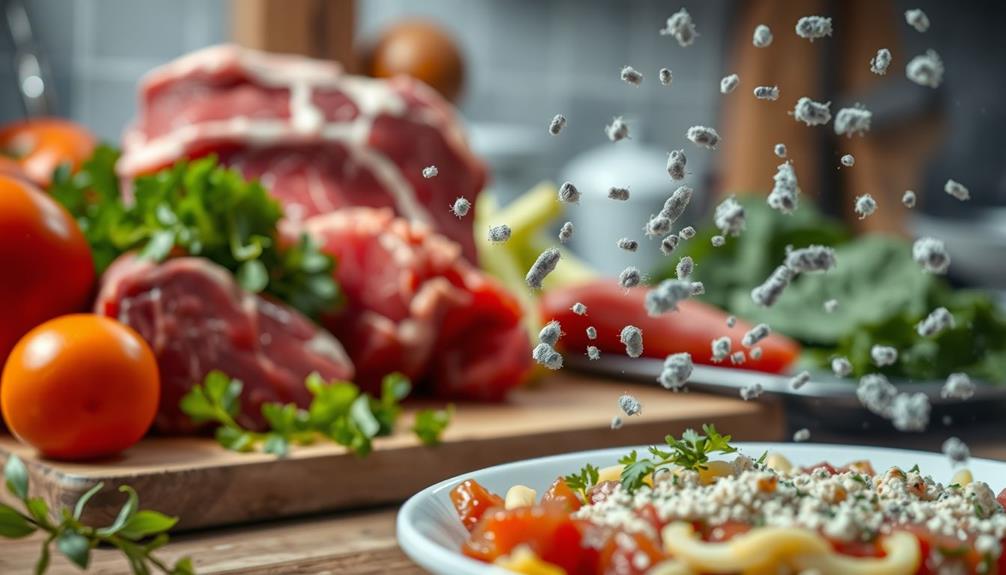
Under ideal conditions, bacteria can double in number every 10 to 20 minutes, making the speed of bacterial spread alarmingly rapid. This rapid multiplication greatly increases the risk of contamination from raw food to ready-to-eat foods. Understanding this speed can help you take necessary precautions.
Here are some key points to bear in mind:
- Immediate Transfer: Cross-contamination can occur almost instantly upon contact, with bacteria moving through surfaces, utensils, or hands within seconds. Proper hygiene practices, such as regular handwashing and sanitizing surfaces, are vital to prevent the rapid spread of bacteria, similar to the care required for hamster health checks.
- Danger Zone: Leaving raw food in the danger zone (40°F-140°F or 4°C-60°C) for over 2 hours greatly increases the likelihood of bacteria spreading.
- Microbial Load: The initial microbial load on raw foods directly influences how quickly contamination happens; higher loads mean faster spread.
- Hygiene Practices: Effective hygiene practices, like handwashing and sanitizing surfaces, are essential. Improper handling can result in contamination within moments.
Risks of Cross-Contamination

Cross-contamination poses a major threat in any kitchen environment, especially when raw foods like meat or poultry come into contact with surfaces or ready-to-eat items. This can occur within minutes, leading to bacterial contamination that puts you at risk of foodborne illness.
For instance, using the same cutting board for raw meat and ready-to-eat foods without proper cleaning can result in pathogens transferring between food contact surfaces, making your meals unsafe.
It's essential to be aware of the mammography guidelines that emphasize the importance of early detection in health, similar to how proper food handling can prevent illness.
Bacteria like Salmonella can double in number every 20 minutes under ideal conditions, particularly in the danger zone between 40°F and 140°F. If ready-to-eat foods are left in this temperature range, they can quickly become contaminated if not handled properly.
You must also remember the importance of handwashing; unwashed hands can easily transfer bacteria from raw foods to other ingredients. Always wash your hands with soap for at least 20 seconds after handling raw meat.
Safe Food Handling Practices

To guarantee your meals are safe, practicing effective food handling techniques is vital. Following these safe food handling practices can greatly reduce the risk of bacterial contamination, similar to how caregivers manage health risks for the elderly, safeguarding their well-being.
financial considerations for elderly care are also important in maintaining a safe environment.
- Wash Hands Properly: Always wash your hands for at least 20 seconds after handling raw foods to prevent cross-contamination.
- Separate Cutting Boards: Use distinct cutting boards for raw meats and ready-to-eat foods to avoid transferring harmful bacteria.
- Store Foods Correctly: Keep raw meats on the bottom shelf of the refrigerator to prevent their juices from dripping onto other perishable foods.
- Follow the Two-Hour Rule: Never leave perishable foods in the danger zone (40°F-140°F) for more than two hours; this helps minimize bacteria growth.
Additionally, verify all cooked items reach a minimum internal temperature of 165°F.
By committing to these practices, you'll not only protect yourself and your loved ones but also enjoy peace of mind knowing your meals are safe.
Importance of Cooking Temperatures
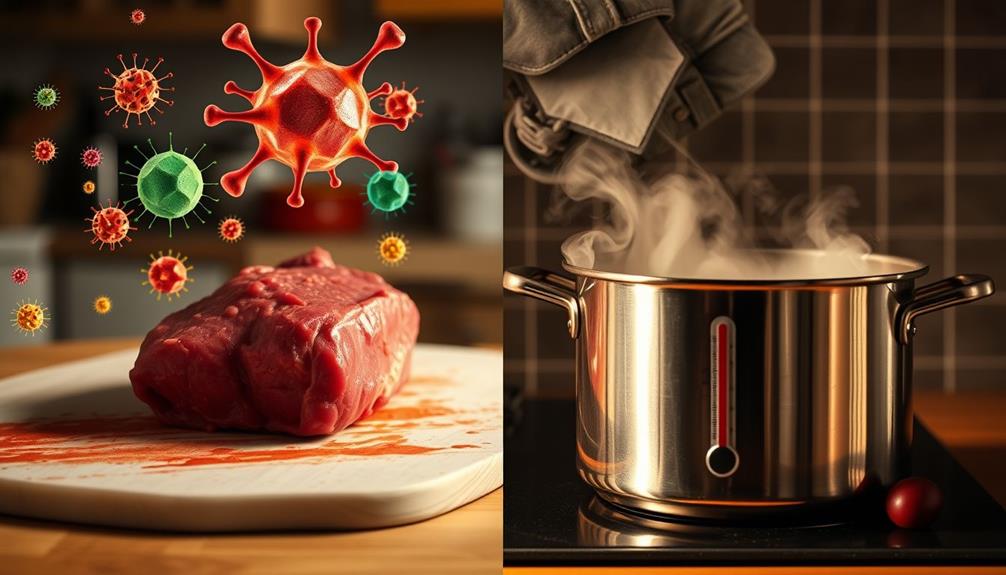
Cooking temperatures are essential for guaranteeing food safety and preventing foodborne illnesses. When you properly cook food, you notably reduce the risk of bacteria that cause foodborne illness. For instance, raw meat, like ground beef, must reach a safe internal temperature of at least 160°F (71.1°C) to kill harmful bacteria such as E. coli and Salmonella.
Additionally, using advanced technology in cooking appliances can help achieve precise cooking temperatures more consistently, much like how energy-efficient models can enhance home heating and cooling systems. Poultry is even more important; it needs to hit 165°F (73.9°C) to eliminate bacteria like Campylobacter and Salmonella, commonly found in raw chicken.
Using a food thermometer is essential to achieving these temperatures, as relying on color and texture can be misleading. Many people underestimate the importance of this tool and end up with improperly cooked food.
When reheating leftovers, verify the food reaches at least 165°F (73.9°C) to effectively kill any bacteria that may have multiplied during storage. Remember, cooking your food to the appropriate temperatures isn't just a guideline; it's a crucial step in protecting yourself and others from foodborne illnesses.
Effective Food Storage Solutions
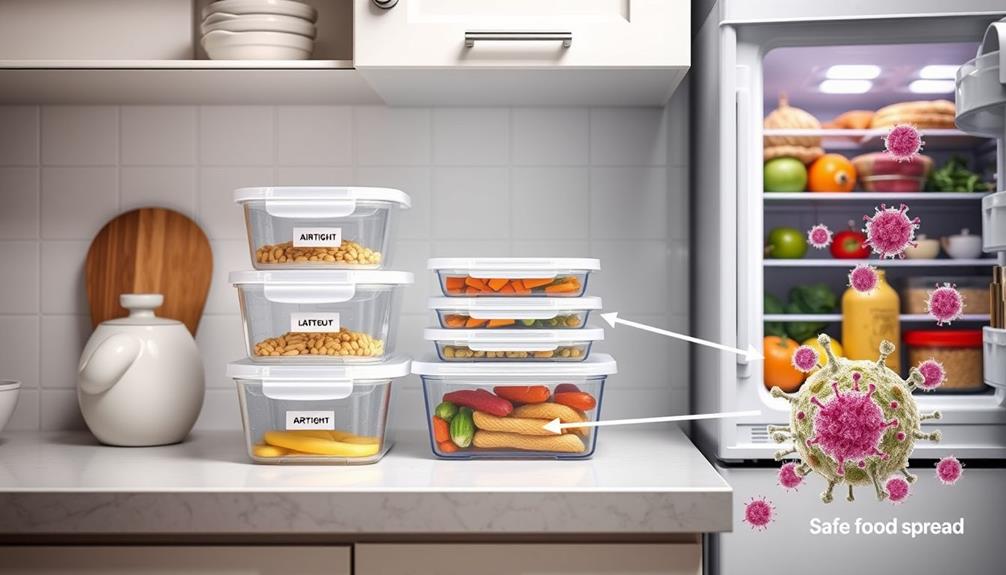
To keep your food safe, it's essential to control temperatures and separate raw from ready-to-eat items.
Regularly cleaning your kitchen appliances, including air purifiers, can help maintain a hygienic environment and reduce airborne bacteria that may settle on food surfaces air purifier maintenance.
Store perishable foods at or below 40°F and always place raw meats on the bottom shelf to prevent any leaks.
Proper Temperature Control
Effective food storage solutions hinge on proper temperature control, which is essential for preventing bacterial growth and cross-contamination.
When food is kept in the danger zone (40°F-140°F or 4°C-60°C), bacteria can double in number every 10 to 20 minutes, increasing the risk of foodborne illness. To enhance your food safety measures, consider implementing best practices for preventing cross-contact as well.
To guarantee food safety, keep these points in mind:
- Refrigerate foods: Store refrigerated foods at or below 40°F (4°C) to slow bacterial growth.
- Freeze leftovers: Freeze leftovers at or below 0°F (-18°C) to halt bacterial growth entirely. Use them within 3-4 days.
- Thaw safely: Always thaw raw meat and other foods in the refrigerator to maintain a safe temperature throughout the process.
- Reheat properly: Cooked foods must be reheated to a minimum internal temperature of 165°F (74°C) to effectively kill harmful bacteria.
Safe Food Separation
While it may seem simple, safe food separation is essential for preventing the spread of harmful bacteria in your kitchen. Cross-contamination can occur within minutes when raw meat comes into contact with ready-to-eat foods or unsanitized surfaces.
To combat this, always use separate cutting boards for raw meats and ready-to-eat foods. This practice markedly reduces the risk of bacteria transferring to items you plan to consume without cooking. Additionally, consider using essential oils such as tea tree oil for its antimicrobial properties, which can help keep your kitchen surfaces sanitized.
When storing food, keep raw meats on the bottom shelf of your refrigerator to prevent drips that could contaminate other foods. Additionally, after handling raw food, wash your hands with soap for at least 20 seconds to minimize the risk of transferring bacteria to ready-to-eat items.
Regularly clean all surfaces and utensils that come into contact with raw meat. This thorough sanitation is key to food safety.
Preventive Measures in Food Safety
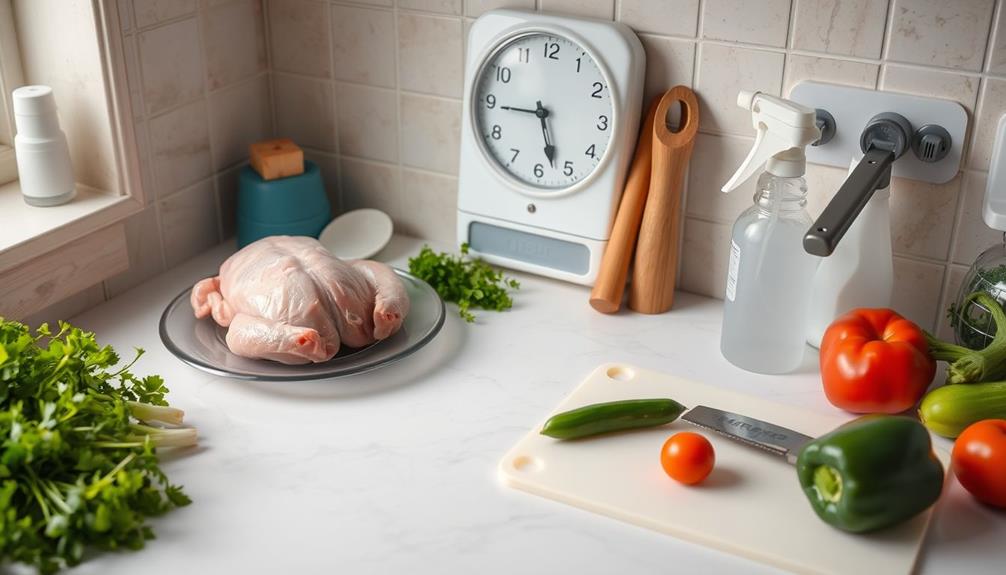
When it comes to food safety, being proactive can make all the difference in preventing harmful bacteria from spreading. Bacterial contamination can occur quickly, especially when handling raw meat.
To help you prevent foodborne illnesses, follow these essential preventive measures:
- Use Separate Cutting Boards: Always use distinct cutting boards for raw and cooked foods to minimize cross-contamination risks during meal prep.
- Proper Washing: Wash your hands with soap for at least 20 seconds after handling raw foods. This step is vital to eliminate any bacteria before touching ready-to-eat items.
- Clean and Sanitize: After using surfaces and utensils for raw foods, clean and sanitize them thoroughly. This helps prevent any bacteria from transferring to other food items.
- Monitor Time: Don't leave food at room temperature for more than 2 hours; this increases the risk of bacterial growth and potential contamination.
Monitoring Bacterial Growth
Monitoring bacterial growth is essential to maintaining food safety, especially after implementing preventive measures. Bacteria can double in number every 10 to 20 minutes under ideal conditions, which makes it vital to keep an eye on how they spread from raw food to ready-to-eat items.
Contamination can occur within minutes if raw food touches surfaces, utensils, or hands that come in contact with ready-to-eat foods. To prevent this, always monitor the temperature of your food. The "danger zone" lies between 40°F and 140°F, where bacteria thrive and multiply rapidly.
Keeping raw meats separate from ready-to-eat foods is essential; even brief contact can transfer harmful bacteria. Regularly inspecting food contact surfaces and ensuring they're clean is a must in your food safety routine.
Use sanitizing solutions and follow proper sanitation practices to minimize the risk of bacterial growth. By actively monitoring these factors, you can safeguard against cross-contamination and protect yourself and others from foodborne illnesses.
Tips for Safe Food Consumption
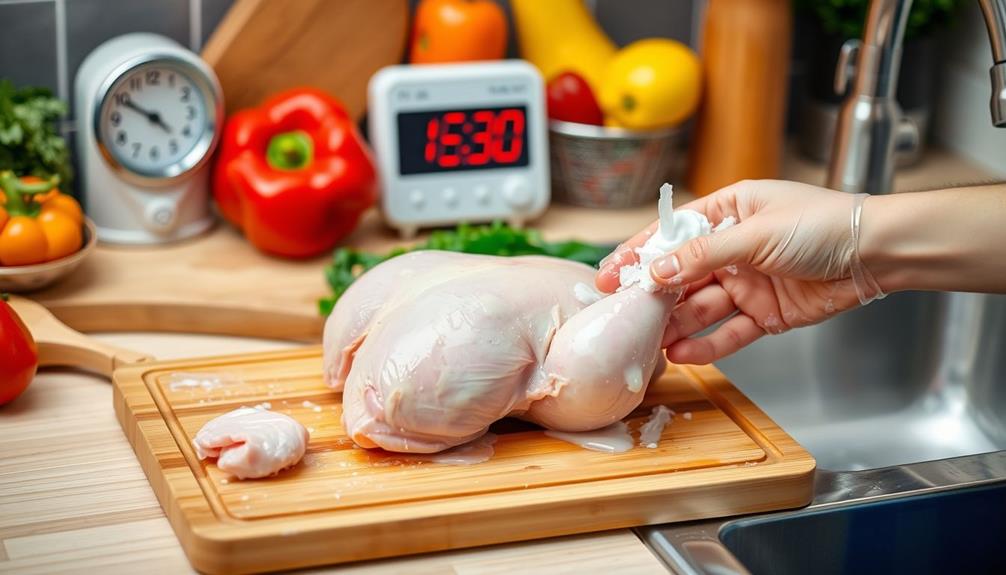
When it comes to safe food consumption, proper handwashing techniques and safe food storage practices are essential.
You should always wash your hands thoroughly after handling raw food to cut down on bacterial risk.
Additionally, ensuring your food is stored at the right temperatures can help keep harmful bacteria at bay.
Proper Handwashing Techniques
Proper handwashing techniques are vital for keeping your food safe from harmful bacteria. By properly washing your hands, you can prevent the transfer of bacteria from raw meat or poultry to ready-to-eat foods.
Follow these steps for effective handwashing:
- Use soap and warm water: Wet your hands with warm water, apply soap, and lather thoroughly.
- Scrub for at least 20 seconds: Make sure you scrub all surfaces, including between your fingers and under your nails.
- Rinse well: Rinse your hands under clean, running water to remove all soap and bacteria.
- Dry with a clean cloth: Use a clean towel or air dryer, as damp hands can transfer bacteria back onto your hands or food.
Remember to wash your hands before and after handling raw meat, poultry, seafood, and eggs to maintain food safety.
It's also important to wash after using the restroom, handling pets, or touching any potentially contaminated surfaces.
Hand sanitizers aren't a substitute for soap and warm water, so stick to these handwashing techniques for the best results!
Safe Food Storage Practices
Safety in food storage is essential to prevent the spread of harmful bacteria from raw to ready-to-eat foods. To keep your meals safe, always store raw meat and poultry in sealed containers on the bottom shelf of your refrigerator. This practice avoids cross-contamination, which can occur when juices from raw foods drip onto other foods.
Using separate cutting boards for raw meats and vegetables is another key part of effective food handling practices, minimizing the risk of harmful bacteria transferring to your ready-to-eat meals.
After you handle raw food, wash your hands, utensils, and surfaces immediately with hot, soapy water to eliminate any lingering bacteria.
Remember the two-hour rule: perishable foods left out at room temperature for more than two hours should be discarded, as bacteria multiply rapidly in these conditions.
Frequently Asked Questions
How Long Does It Take for Bacteria to Grow on Cooked Food?
Bacteria can grow on cooked food within just two hours if left at room temperature. In ideal conditions, they might double every 10 to 20 minutes, making it essential to store food properly to guarantee safety.
How Long Does It Take for Bacteria to Contaminate Food?
Bacteria can contaminate food within just 20 minutes under ideal conditions. If you leave food in the danger zone or don't sanitize surfaces, the risk of cross-contamination increases considerably, so always practice proper hygiene.
How Fast Does Bacteria Move on Food?
Bacteria can race across your kitchen like a cheetah on a hunt! They spread rapidly, doubling every 10 to 20 minutes when conditions are right, especially if you neglect proper hygiene and cross-contamination precautions.
How Do You Get Rid of Bacteria From Ready To-Eat Raw Food?
To get rid of bacteria from ready-to-eat food, wash fruits and veggies under running water, cook foods to at least 165°F, and use separate utensils. Don't forget to sanitize surfaces and wash your hands.
Conclusion
In today's fast-paced world, you can't afford to let bacteria crash your kitchen party. By understanding how quickly bacteria can spread from raw food to ready-to-eat items, you can take the right steps to keep your meals safe. Remember to practice safe food handling, store items properly, and always be vigilant about cross-contamination. With these preventive measures, you'll guarantee that your culinary creations are not just delicious but also safe to enjoy!

